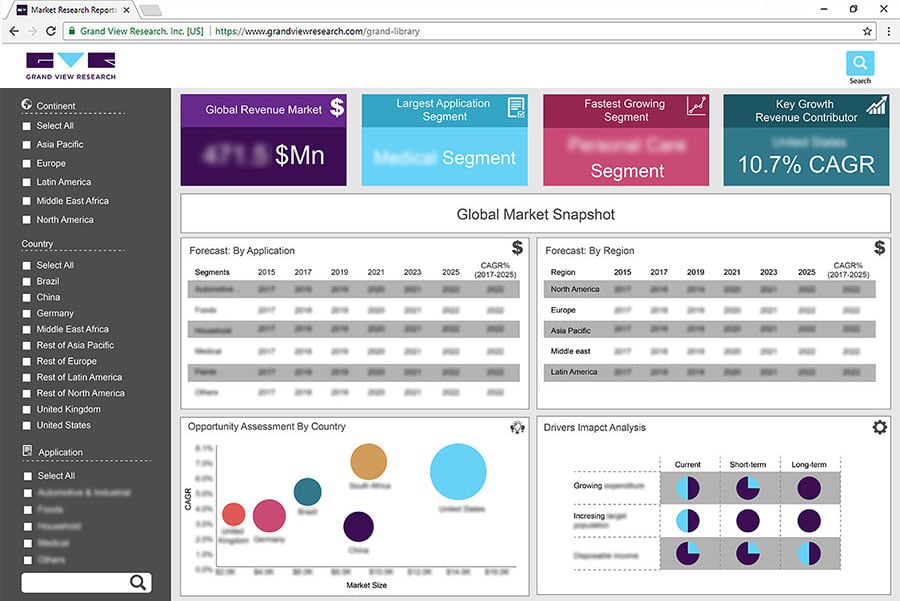
U.S. Household Appliances Market Size, Share & Trends Analysis Report By Product (Water Heater, Dishwasher, Refrigerator, Washing Machine, Air Conditioner), By Distribution Chanel, By Region, And Segment Forecasts, 2024 - 2030
- Report ID: GVR-2-68038-146-7
- Number of Pages: 96
- Format: Electronic (PDF)
- Historical Range: 2018 - 2023
- Industry: Consumer Goods
Market Segmentation
- U.S. Household Appliances Market Product Outlook (Revenue, USD Million, 2018 - 2030)
- Water Heater
- Dishwasher
- Refrigerator
- Cooktop, Cooking Range, Microwave, and Oven
- Vacuum Cleaner
- Mixer, Grinder, and Food Processor
- Washing Machine
- Air Conditioner
- U.S. Household Appliances Market Distribution Channel Outlook (Revenue, USD Million, 2018 - 2030)
- Brick & Mortar
- E-Commerce
- U.S. Household Appliances Market Regional Outlook (USD Million, 2018 - 2030)
- Northeast
- Northeast U.S. Household Appliances Market, by Product
- Water Heater
- Dishwasher
- Refrigerator
- Cooktop, Cooking Range, Microwave, and Oven
- Vacuum Cleaner
- Mixer, Grinder, and Food Processor
- Washing Machine
- Air Conditioner
- Northeast U.S. Household Appliances Market, by Distribution Channel
- Brick & Mortar
- E-Commerce
- Northeast U.S. Household Appliances Market, by Product
- Southeast
- Southeast U.S. Household Appliances Market, by Product
- Water Heater
- Dishwasher
- Refrigerator
- Cooktop, Cooking Range, Microwave, and Oven
- Vacuum Cleaner
- Mixer, Grinder, and Food Processor
- Washing Machine
- Air Conditioner
- Southeast U.S. Household Appliances Market, by Distribution Channel
- Brick & Mortar
- E-Commerce
- Southeast U.S. Household Appliances Market, by Product
- Southwest
- Southwest U.S. Household Appliances Market, by Product
- Water Heater
- Dishwasher
- Refrigerator
- Cooktop, Cooking Range, Microwave, and Oven
- Vacuum Cleaner
- Mixer, Grinder, and Food Processor
- Washing Machine
- Air Conditioner
- Southwest U.S. Household Appliances Market, by Distribution Channel
- Brick & Mortar
- E-Commerce
- Southwest U.S. Household Appliances Market, by Product
- Midwest
- Midwest U.S. Household Appliances Market, by Product
- Water Heater
- Dishwasher
- Refrigerator
- Cooktop, Cooking Range, Microwave, and Oven
- Vacuum Cleaner
- Mixer, Grinder, and Food Processor
- Washing Machine
- Air Conditioner
- Midwest U.S. Household Appliances Market, by Distribution Channel
- Brick & Mortar
- E-Commerce
- Midwest U.S. Household Appliances Market, by Product
- West
- West U.S. Household Appliances Market, by Product
- Water Heater
- Dishwasher
- Refrigerator
- Cooktop, Cooking Range, Microwave, and Oven
- Vacuum Cleaner
- Mixer, Grinder, and Food Processor
- Washing Machine
- Air Conditioner
- West U.S. Household Appliances Market, by Distribution Channel
- Brick & Mortar
- E-Commerce
- West U.S. Household Appliances Market, by Product
- Northeast
U.S. Household Appliances Market Dynamics
Driver: Growth Of The Luxury Residential Market
The surge in the U.S. luxury home market has triggered an increased need for top-tier household appliances. The 2021 Sotheby’s International Realty Survey reveals that 63% of real estate professionals anticipate a rise in luxury home prices over the next three years, and more than 70% observed an increased demand for such homes in 2020. In a similar vein, the National Association of Realtors (NAR) data indicates a 244.5% year-over-year surge in U.S. home sales priced over USD 1 million in May 2021. This growth significantly surpasses the 47.9% increase in sales of homes priced between USD 250,000 and USD 500,000 during the same timeframe. Millennials recognized as the most educated and influential consumer group, have come to value spacious homes with larger rooms, green spaces, children's playrooms, dedicated office spaces, and various amenities, particularly in the wake of the COVID-19 pandemic. Consequently, the real estate sector has been tailoring its offerings to align with millennials' home-buying preferences, ensuring the continued expansion of the real estate marketplace.
Rising Home Remodeling Projects
Transformations in lifestyle, increased exposure through travel, and advancements in design have paved the way for contemporary living standards. Enhanced spending power and better infrastructure have sparked a demand for sophisticated household appliances, aiming to bring comfort to kitchens and homes at large. As property prices rise, individuals are investing more in home renovations or remodeling projects to modernize their conventional homes. The U.S. economy experienced steady growth with an increase in home prices and low unemployment rates from 2010 to 2020, resulting in homeowners having more equity and reducing the number of homes in negative equity. Despite the temporary slowdown in April 2020 due to the COVID-19 pandemic, home prices have been maintained and flourished, thanks to record-low mortgage rates and inventory across the U.S. Furthermore, a report by CoreLogic revealed that U.S. homeowners saw a gain of USD 9,800 at the end of Q2 2020, marking a 6.6% increase year-over-year. The surge in home values has led to a doubling of homeowner equity, suggesting a trend of homeowners feeling wealthier and more inclined to invest in home improvement projects.
Restraint: Harmful Effects Of Chemicals Used In Household Appliances
Household appliances, such as refrigerators, are known to house refrigerants that contain detrimental chemicals known as fluorinated hydrocarbons. When inhaled deeply, this chemical has the potential to deprive cells and lungs in the human body of crucial oxygen. Furthermore, frequent inhalation of high concentrations of fluorinated hydrocarbons emitted by refrigerators can lead to health issues such as difficulty breathing, fluid accumulation in the lungs, damage to organs, or even sudden death. Exposure to refrigerant chemicals that is mild to moderate is typically harmless but can still lead to minor health problems. Symptoms of mild to moderate poisoning encompass headache, irritation in the eyes, throat, and ears, vomiting, nausea, cough, frostbite, dizziness, and chemical burns on the skin. Certain chemicals present in refrigerants linger in the body for an extended period. They readily bind to fat molecules and can be stored in fatty tissues. Symptoms of severe poisoning encompass vomiting blood, fluid accumulation or bleeding in the lungs, a burning sensation in the esophagus, decreased mental status, irregular heart rate, loss of consciousness, difficulty breathing, labored breathing, and seizures. As per the National Institute on Drug Abuse, it was reported that inhalant misuse, such as refrigerants, was reported by 12.6% of children aged between 10 and 15 in 2020, an increase from 9.5% in 2019.
What Does This Report Include?
This section will provide insights into the contents included in this U.S. household Appliances market report and help gain clarity on the structure of the report to assist readers in navigating smoothly.
U.S. Household appliances market qualitative analysis
-
Industry overview
-
Industry trends
-
Market drivers and restraints
-
Market size
-
Growth prospects
-
Porter’s analysis
-
PESTEL analysis
-
Key market opportunities prioritized
-
Competitive landscape
-
Company overview
-
Financial performance
-
Product benchmarking
-
Latest strategic developments
-
U.S. Household appliances market quantitative analysis
-
Market size, estimates, and forecast from 2018 to 2030
-
Market estimates and forecast for product segments up to 2030
-
Regional market size and forecast for product segments up to 2030
-
Market estimates and forecast for application segments up to 2030
-
Regional market size and forecast for application segments up to 2030
-
Company financial performance



